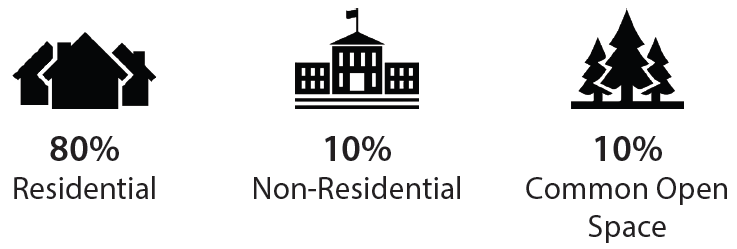 Place Types - Neighborhood 2
Place Types - Neighborhood 2
 Place Types - Neighborhood 2
Place Types - Neighborhood 2
Place Types are a classification of land that provides guidance for how future development should look and function. They describe types and intensities of land use as well as important characteristics such as scale, site design, and accessibility. These draft policies will be reviewed by staff and the community, with a final draft document anticipated in Fall 2018. You are reviewing Neighborhood 2, one of 14 different Place Types. Thank you for your time and interest in shaping the future of our community.
DRAFT Document - Neighborhood 2
Click this link to open a full copy of Place Types - Neighborhood 2.
You'll need this for reference as you take the survey.
Summary
(Sidebar on right side of document)
This section summarizes the intent and rataionale for the "building blocks" of Place Types. These "building blocks" range from Land Use to Transportation.
Please share any questions/comments you have on the following "building blocks".
Goals
- Accommodate a range of moderate intensity residential housing choices which contribute to citywide housing diversity.
- Integrate Neighborhood 2 into surrounding Neighborhood Place Types to develop complete neighborhoods.
Land Use
- Neighborhood 2 is a residential neighborhood that accommodates a range of moderate intensity housing choices, to provide housing choices for different needs and preferences.
- Common open spaces, neighborhood parks, greenways, and civic/ institutional uses may also be incorporated in Neighborhood 2.
Urban Design
- Neighborhood 2 is characterized by attached building types which may include townhomes or house courts.
- Buildings are low-rise but the moderate intensity of this place provides a good transition between Neighborhood 1 and 3.
Transportation
- Neighborhood 2 should be located in areas with a high level of local street connectivity to support pedestrians and cyclists, while providing multiple access points for motorists to disperse traffic.
- Arterial Streets should provide for safe and comfortable travel along and across them, to help provide access to nearby Centers, transit, and other destinations.
Elements
(Items starting at lower left corner of document, eg. Typical Mix of Uses)
This section further refines the "building blocks" mentioned in the Summary. These city-building characteristics range from Building Size to Sidewalks and vary from Place Type to Place Type.
Typical Mix of Uses
Zoning Districts
- There are various forms this place type can take and therefore several zoning districts will be needed to implement the full range of anticipated development patterns.
- Specific Zoning Districts will be developed for this Place Type and included here.
Building Types
- A variety of housing choice is critical for providing housing choices for residents with varying preferences and household sizes.
- Primary building types are townhomes, house courts, and similar attached units.
- Single family, duplexes, triplexes, and quadraplexes are also appropriate.
- Non-residential buildings for civic and institutional uses are typically located on Arterial Streets and corners.
Building Size
- Building sizes throughout Neighborhood 2 are typically of low residential scale to maintain the character of a residential neighborhood.
- Residential buildings will vary in size.
- Non-residential buildings for civic and institutional uses are typically less than 10,000 square feet. The sizes of civic and institutional buildings vary based on context and accessibility.
Building Length Along the Street Frontage
- Typical building length is no greater than 100’-150’ per building, and they are preferably no greater than 70 feet in length.
- Neighborhood 2 is often located near Neighborhood 1, so compatible building lengths are important to maintain the residential character, create a more interesting and comfortable pedestrian environment, and allow for a better block structure.
Building Height
- Buildings in Neighborhood 2 are typically low-rise and range from 1 to 3 stories.
- Appropriate height transition is important for maintaining the character of a neighborhood and can be addressed by maintaining similar roof height to adjacent buildings.
- Building heights may increase in the rear of a structure away from the street if the size of the side and rear yards can provide an appropriate transition to adjacent low-intensity development.
Yards
- The front yard is a shared characteristic between Neighborhood 1 and Neighborhood 2 places.
- The front yard establishes the front setback and should be generally consistent along a block.
- The front yard is semi-private open space for a residential property.
- Side yards will typically occur along the edges of a lot rather than between units.
- Transition of buildings on these sites to adjacent properties can be addressed with appropriate side yards, in combination with height, setbacks, landscaping, and access points.
Orientation
- Principal buildings are oriented toward the street on which they have frontage and individual units should have a sidewalk connection between the unit entrance and the street.
- Multi-unit buildings on corner lots are encouraged to have entrances that front on both streets.
- Buildings should not be oriented toward a driveway, alley, or parking lot/structure.
Building Relationship to Local Streets and Avenues With On-Street Parking
- Along Local Streets, setbacks are generally consistent with any nearby residences and typically include a front yard area and semiprivate open space.
- Multi-unit buildings (plex homes, townhomes, etc.) on corner lots are encouraged to address and provide entrances on both street fronts.
- Buildings should not be oriented toward a driveway, parking lot/ structure, or alley.
- Principal buildings are oriented to the street and individual units should each have entrances from the sidewalk along the street. Those entrances are typically raised from the sidewalk level to provide additional privacy to residents.
- Buildings typically make up about 70% of the lot frontage along a Local Street. Driveways and parking should make up less than 10%. The remainder may be devoted to open spaces and breaks in buildings.
Building Relationship to Arterial Streets (Except Avenues with On-Street Parking)
- Along Arterial Streets, setbacks may be greater and in some cases, the buildings might be oriented to an internal street network depending on the context and relationship of other residences and places in the area.
- When a site is along an Arterial Street but orients to a Local Street, an appropriately placed and designed wall or screening may be provided to create a visual edge along the Arterial Street and separation from the street for the residences while maintaining comfort for pedestrians traveling along the sidewalk.
- When oriented to an Arterial Street, individual units should have a connection between the unit entrance and the street. Entrances are typically raised above the sidewalk to provide additional privacy to residents.
- Buildings typically make up about 70% of the lot frontage along an Arterial Street. Driveways and parking should make up less than 10%. The remainder may be devoted to open spaces and breaks in buildings.
Building Coverage and Impervious Surface
- Low to moderate building and impervious coverage help ensure Neighborhood 2 has plenty of open space which is important for multiple environmental and recreational purposes.
- Typical impervious coverage is less than 50% of a Neighborhood 2 site overall.
Open Space and Yards
- Yards and common open spaces comprise much of the open space areas.
- Open spaces should occupy approximately 40% of a Neighborhood 2 site, which may include active and passive common open spaces, buffers and planting strips, storm water facilities, and yards.
- Trees planted in yards and open spaces significantly contribute toward the City’s tree canopy.
- Neighborhood parks and greenways may also be located in Neighborhood 2.
Connectivity
- A goal of connectivity is to stitch together a street network that supports trips made by walking, biking, and driving.
- A connected street network increases accessibility throughout a neighborhood to homes and services. Generally, shorter blocks enable more route choices and promote walkability.
- Block lengths are typically 400’-600’ in urban (or infill) locations.
- Block lengths are typically 600-800’ in suburban (or greenfield) locations.
Pedestrian Network
- Appropriately sized sidewalks enable safe, comfortable transportation and recreation choices for residents that connect homes and destinations.
- Sidewalks should be installed in new neighborhoods and are desired in existing neighborhood without sidewalks today.
- The pedestrian network should include off-street connections from streets to adjacent greenways, parks, schools, and other streets where possible.
- Entrances to buildings should be aligned with existing pedestrian facilities where feasible.
Parking
- On-street parking is appropriate along most Local Streets, and alley access is encouraged.
- Shared driveways are encouraged, particularly for areas transitioning to more intense Place Types and along Arterial Streets. Shared driveways are strongly encouraged for multui-unit buildings (plex buildings, townhomes, etc.).
- Parking is preferably located to the rear of buildings. Parking lots should be screened from view of the street but should not discourage pedestrian access to the site or inhibit clear sight lines of the pedestrian realm (to ensure “eyes on the street” and a safe walking environment).
Vehicular Access
- Shared driveways reduce the number of driveways along a street thereby increasing green space and decreasing conflict points between pedestrians/cyclists and automobiles. This type of access is particularly encouraged for plex buildings, house courts, and townhomes.
- Driveway access is preferably located along a Local Street, though allowable along Arterial Streets.
- Alleys provide access and parking for residents and reduce driveways along.
Streets
- Due to the higher intensity of development, Local Streets are typically Wide Residential, to allow for on-street parking and maneuvering traffic, or Narrow Residential with alley-fed parking or other on-site parking.
- Local streets should reflect the surrounding development intensity, but will not typically include the medium cross-section due to the mix of housing types.
- Arterial Streets should be designed to provide for safe and comfortable travel along and across them. Most Arterial Streets adjacent to these neighborhoods will be Avenues or Boulevards.
- Target speeds should be low (preferably maximum 25mph on Local Streets, XXmph on Arterial Streets).
Sidewalks
- Sidewalks should enable safe access throughout the neighborhood.
- Sidewalks are typically 6’ wide (unobstructed) along Local Streets.
- Sidewalks should be a minimum of 6’- 8’ (unobstructed) depending on intensity along Arterial Streets. Wider sidewalks should be used where the neighborhood is transitioning to a Center or Neighborhood Node, particularly along an Avenue.
- Where appropriate (based on bicycle facility matrix pg XX or other plan), a multi-use path should be a minimum 12’ (unobstructed), particularly along Boulevards with limited driveways.
Green Zone
- The Green Zone is typically no less than 8’ wide to accommodate shade trees, grass, and/or hardscape elements. It provides separation between pedestrians and vehicles, helps calm traffic, provides an attractive public realm, contributes to the City’s tree canopy, and shades the streets and users.
- In most areas of Neighborhood 2, a grassed or vegetated planting strip is appropriate.
- In areas of Neighborhood 2 that are more urban and/or transitioning to a Neighborhood Node or other more intense Place Type, a hardscaped amenity area with trees in grates is encouraged in lieu of a planting strip.
Bicycle Facilities
- Dedicated bike facilities are expected on most Arterial Streets due to higher speeds and volumes.
- Shared lanes are typical on internal Local Streets, since speeds and traffic volumes should be low.
- Design of the bicycle facility varies (see general provisions, p. XX, for factors influencing bike facilities).
Street Furnishings
- Street furnishings should be located in the Green Zone or on-site to keep the sidewalk unobstructed.
- Bus stops should be accessible via a sidewalk and ideally include benches and trash receptacles, or shelters and pads at higher ridership locations (near significant concentrations of destinations).
